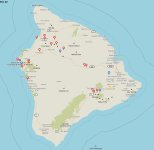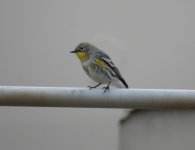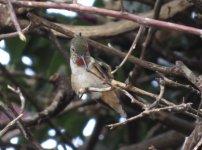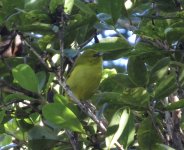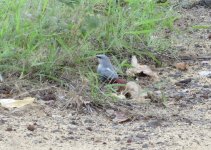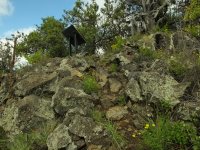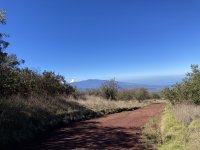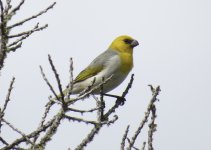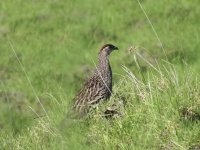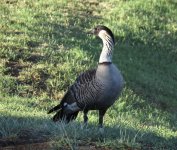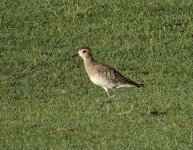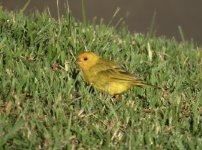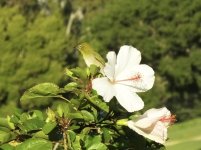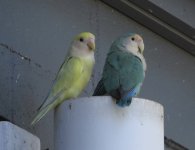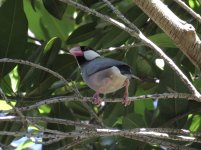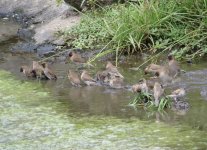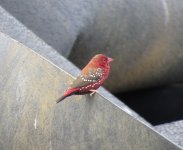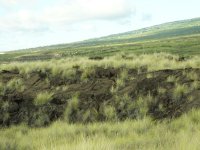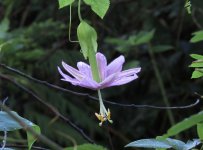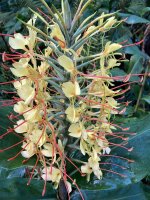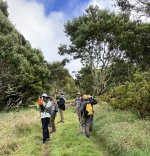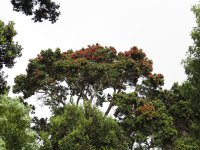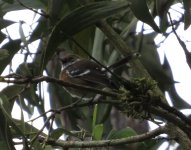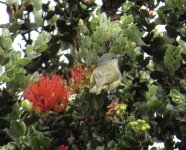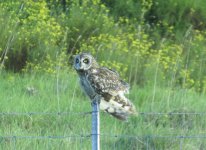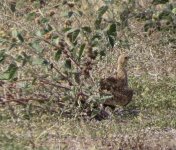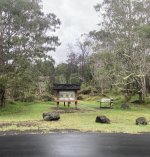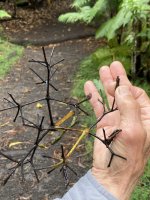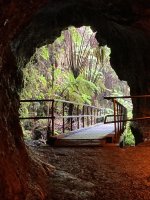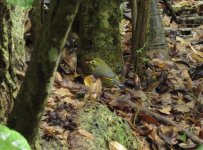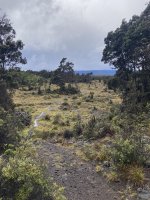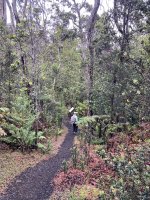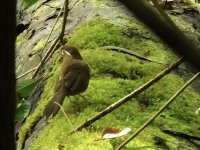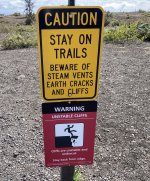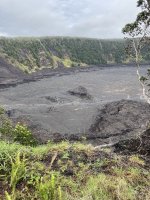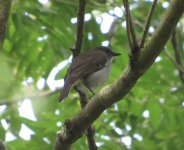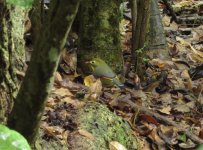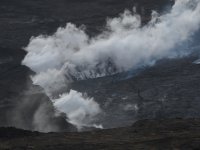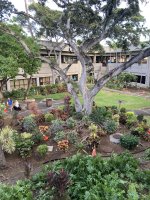Hamhed
Well-known member
Some random thoughts as a preface:
It is our hope that this report on birding the Big Island and Oahu will be of special benefit to US birders planning a visit to increase their ABA life list. This trip was limited to two of the Hawaiian Islands. Kauai was originally a third possibility. The difficulty of seeing its endemic birds and the cost required to do so meant scaling back to more achievable goals. We had a target of about fifty two species possible for our own list and came closer to reaching that number than expected. Only fifteen on that list are considered native species, either endemic to the islands or in the case of the Bristle-thighed Curlew, a winter visitor. Six of the endemics on the islands we visited are considered endangered, with the Palila being a critically endangered species. We did not include sub-species in our target list, though in the end, we did see several, saved for potential future use.
Not surprisingly, given the geographical location of the islands, many of the introduced species are from Asia, with several from Africa and South America. A colorful and exotic display of species often overwhelms us when studying lists for a overseas destination, however, given the limited species possible, these two islands did not seem to be as difficult, at least, for visual identification. Vocalizations were never within our grasp to memorize.
Preparation for the birding included adding iBird Hawaii to our phones and iPads. Hours were spent reading trip reports, new and old, from various web locations including Bird Forum (thank you, Ovenbird), watching endless YouTube videos and studying eBird reports for the past several years to help determine where each species would best be found. By phone, I contacted Hawaii Department of Land and Natural Resources and Richard May, leader for Audubon bird walks on Oahu, who remained communicative through most of our stay. I created a spreadsheet to help us understand what was where, adding my own often inaccurate rating as to the difficulty of locating each species.
As a member of the Birding Pal network, I’m sad to say there are almost no Birding Pals in the Hawaiian islands. The one I did contact never responded. Richard May said that the birding community in the islands is actually pretty small. The two birders I was able to contact dropped communication after a single response.
On eBird, I set my Alerts to get daily, emailed reports on what was being seen by other birders in the entire state.
As a method of helping us determine where the best birding and snorkeling locations were in relation to each other and where we might choose to stay, I color marked a simple map on maps.me, a program Niels Larsen suggested to us years ago (thanks, Niels! We’ve used this many times over the years). On this map, I marked birding locations in red, snorkeling in green, Airbnb stays in yellow and points of interest in blue. This was of great help in organizing our travels on each island to minimize any needless driving.
Snorkeling, which we are beginning to see as an aquatic counterpart to birding, was high on our list of activities. Indeed, our check-in bag was mostly filled with wet suits and snorkel tubes. In hindsight, a waterproof camera or GoPro would have been wonderful to share our underwater sightings. In the end, neither made the budget cuts.
We kept a fairly close watch on our budget with constant reminders of higher than typical costs for a domestic location. Choosing the island’s off season for our travel was primary in keeping costs in line. Our plane fare was nearly entirely mitigated by points saved during the 2 1/2 years we avoided travel, thanks to Covid concerns. Airbnb’s were our main choices of lodging. Staying at three hundred a night resorts was not a budget option. Oahu was the more expensive of the two islands. We found it nearly impossible to avoid a nightly stay of less than $200. There were even parked camper vans renting for $150 a night! We seldom (occasionally) ate take out and never at restaurants, shopping at groceries and cooking in facilities within our lodging whenever possible. As vegetarians, this would have been difficult anyway. Hawaiians like their raw fish and meat and this was reflected in all menus.
Alternatively, we relaxed the budget by staying in Los Angeles for a night both coming and going to make the travel effort more absorbable by our aging bodies. In hindsight, this proved worth the cost in time and dollars to us as jet lag in either direction was never a problem. Another budget relaxation was to give ourselves the best chance at seeing the endemic honeycreepers on the Big Island. This meant booking with Hawaii Forest and Trail for a trip to Hakalau Reserve on our on our only guided excursion. A pelagic, though possibly productive, was never in our discussions.
Renting cars was fairly straightforward, so we thought. On the Big Island, we chose to go with an economy model from Enterprise. We arrived after dark and their economy models were all gone so a free upgrade to an intermediate was welcome. The car was rented on the west side in Kona but returned in Hilo on the east coast to save us the cross island drive. More on Oahu car rental later.
Finally, one goof in my original cost analysis was to omit the cost of gas. Though the high number we saw was $5.90 a gallon, the typical price was just over $5 a gallon. The total fuel cost for the trip ended up being more substantial than I might have guessed but not a budget buster.
It is our hope that this report on birding the Big Island and Oahu will be of special benefit to US birders planning a visit to increase their ABA life list. This trip was limited to two of the Hawaiian Islands. Kauai was originally a third possibility. The difficulty of seeing its endemic birds and the cost required to do so meant scaling back to more achievable goals. We had a target of about fifty two species possible for our own list and came closer to reaching that number than expected. Only fifteen on that list are considered native species, either endemic to the islands or in the case of the Bristle-thighed Curlew, a winter visitor. Six of the endemics on the islands we visited are considered endangered, with the Palila being a critically endangered species. We did not include sub-species in our target list, though in the end, we did see several, saved for potential future use.
Not surprisingly, given the geographical location of the islands, many of the introduced species are from Asia, with several from Africa and South America. A colorful and exotic display of species often overwhelms us when studying lists for a overseas destination, however, given the limited species possible, these two islands did not seem to be as difficult, at least, for visual identification. Vocalizations were never within our grasp to memorize.
Preparation for the birding included adding iBird Hawaii to our phones and iPads. Hours were spent reading trip reports, new and old, from various web locations including Bird Forum (thank you, Ovenbird), watching endless YouTube videos and studying eBird reports for the past several years to help determine where each species would best be found. By phone, I contacted Hawaii Department of Land and Natural Resources and Richard May, leader for Audubon bird walks on Oahu, who remained communicative through most of our stay. I created a spreadsheet to help us understand what was where, adding my own often inaccurate rating as to the difficulty of locating each species.
As a member of the Birding Pal network, I’m sad to say there are almost no Birding Pals in the Hawaiian islands. The one I did contact never responded. Richard May said that the birding community in the islands is actually pretty small. The two birders I was able to contact dropped communication after a single response.
On eBird, I set my Alerts to get daily, emailed reports on what was being seen by other birders in the entire state.
As a method of helping us determine where the best birding and snorkeling locations were in relation to each other and where we might choose to stay, I color marked a simple map on maps.me, a program Niels Larsen suggested to us years ago (thanks, Niels! We’ve used this many times over the years). On this map, I marked birding locations in red, snorkeling in green, Airbnb stays in yellow and points of interest in blue. This was of great help in organizing our travels on each island to minimize any needless driving.
Snorkeling, which we are beginning to see as an aquatic counterpart to birding, was high on our list of activities. Indeed, our check-in bag was mostly filled with wet suits and snorkel tubes. In hindsight, a waterproof camera or GoPro would have been wonderful to share our underwater sightings. In the end, neither made the budget cuts.
We kept a fairly close watch on our budget with constant reminders of higher than typical costs for a domestic location. Choosing the island’s off season for our travel was primary in keeping costs in line. Our plane fare was nearly entirely mitigated by points saved during the 2 1/2 years we avoided travel, thanks to Covid concerns. Airbnb’s were our main choices of lodging. Staying at three hundred a night resorts was not a budget option. Oahu was the more expensive of the two islands. We found it nearly impossible to avoid a nightly stay of less than $200. There were even parked camper vans renting for $150 a night! We seldom (occasionally) ate take out and never at restaurants, shopping at groceries and cooking in facilities within our lodging whenever possible. As vegetarians, this would have been difficult anyway. Hawaiians like their raw fish and meat and this was reflected in all menus.
Alternatively, we relaxed the budget by staying in Los Angeles for a night both coming and going to make the travel effort more absorbable by our aging bodies. In hindsight, this proved worth the cost in time and dollars to us as jet lag in either direction was never a problem. Another budget relaxation was to give ourselves the best chance at seeing the endemic honeycreepers on the Big Island. This meant booking with Hawaii Forest and Trail for a trip to Hakalau Reserve on our on our only guided excursion. A pelagic, though possibly productive, was never in our discussions.
Renting cars was fairly straightforward, so we thought. On the Big Island, we chose to go with an economy model from Enterprise. We arrived after dark and their economy models were all gone so a free upgrade to an intermediate was welcome. The car was rented on the west side in Kona but returned in Hilo on the east coast to save us the cross island drive. More on Oahu car rental later.
Finally, one goof in my original cost analysis was to omit the cost of gas. Though the high number we saw was $5.90 a gallon, the typical price was just over $5 a gallon. The total fuel cost for the trip ended up being more substantial than I might have guessed but not a budget buster.






